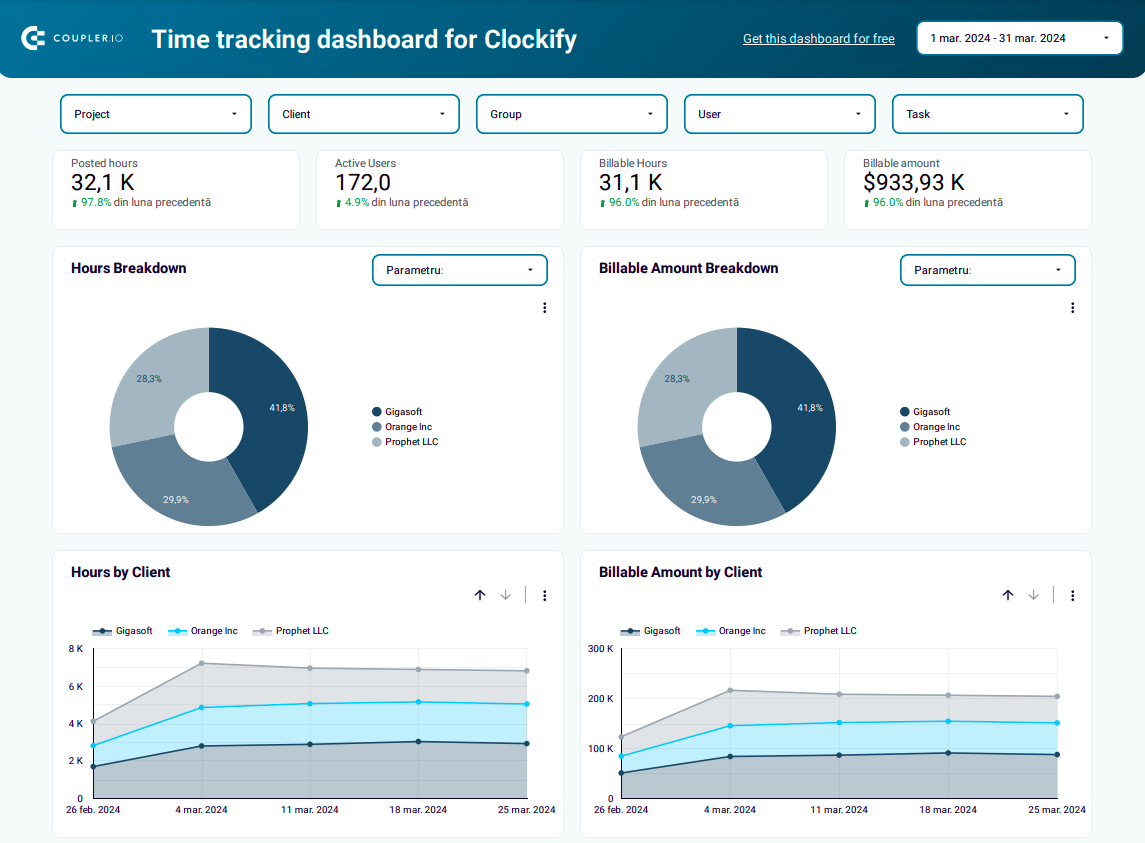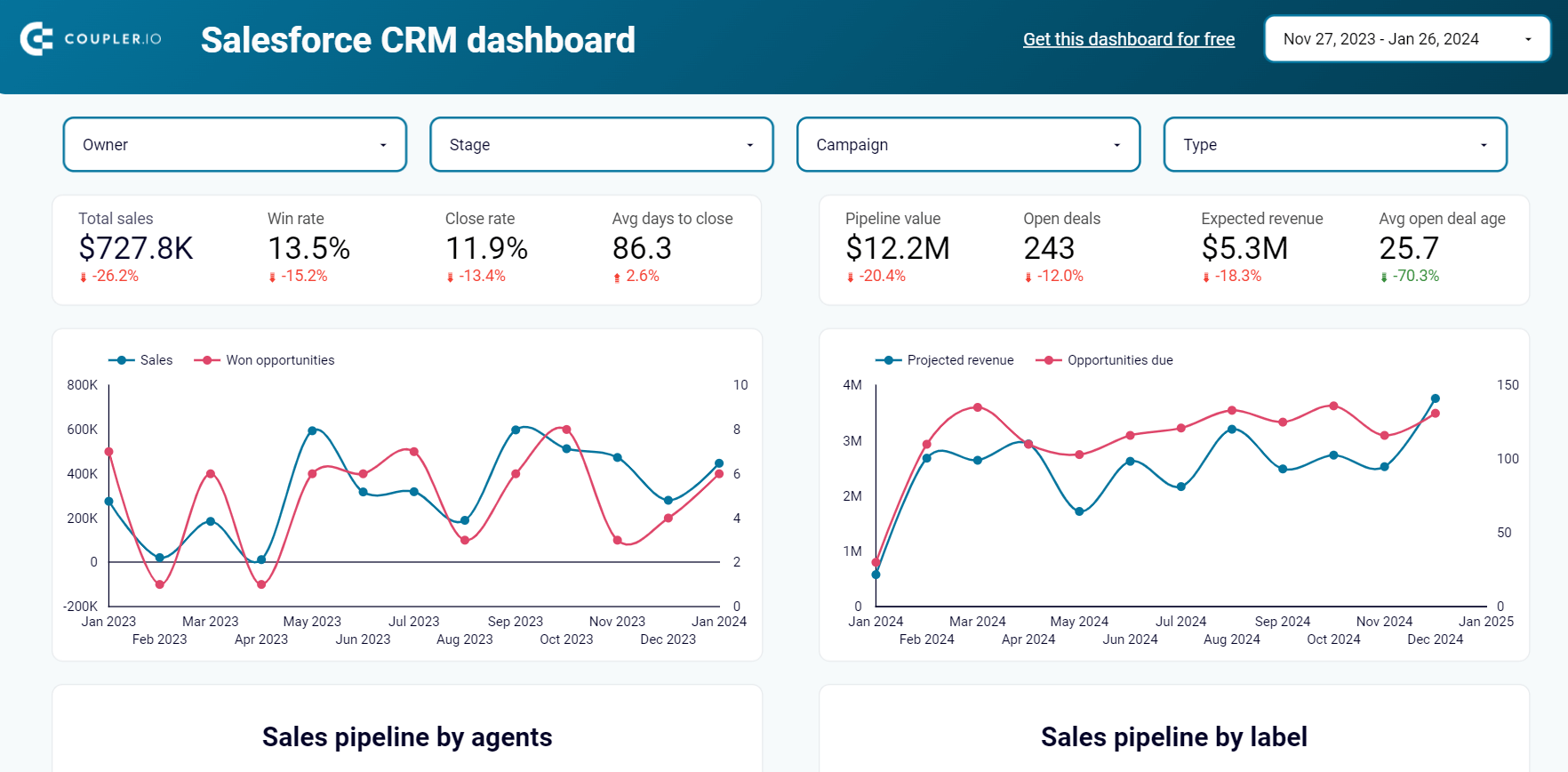Guide on How to Track Employee Performance: Methods, Tools, & Best Practices
Despite the advances in technology, most companies struggle to understand their employee performance. Only 6% of companies are happy with how they track employee performance, while 94% think they can do better. Let’s discuss the required tools, best practices, and different ways to track performance effectively.
6 ways to track employee performance
We’ll briefly discuss the six methods by highlighting the pros and cons to help you choose the most suitable employee performance tracking approaches for your team.
1. Traditional performance reviews
These reviews are conducted annually or bi-annually in most large organizations for the sole purpose of salary increments. It starts at the beginning of the year with the manager setting goals for the employee. At the end of the year, employees are asked to fill out a form about their performance. Simultaneously, the manager also assesses the employee performance based on work quality, leadership, teamwork, problem-solving, etc.
After submitting the respective feedback to the HR manager, a 1 to 1 review meeting is set up to discuss the employees’ progress in detail. Based on the discussions, the employee and the manager agree on a development plan for unmet goals and set new ones for the next year.
Pros of traditional performance reviews:
- The feedback format is structured which makes it measure employee performance in large organizations.
- As the review is followed by a salary raise or promotion, it acknowledges achievements and motivates employees.
Cons of traditional performance reviews:
- The frequency of the review is just once or twice a year, making it difficult to track small wins and give immediate feedback.
- The performance review can be biased as it is mostly dependent on the manager’s qualitative feedback.
2. 360-Degree feedback
As the name suggests, this is an overall feedback to evaluate employee performance where an employee receives feedback from everyone they have worked with during the quarter, half-year, or year. This includes managers, peers, subordinates, and sometimes even clients. It also involves self-assessment, providing a well-rounded view of performance.
If the employee’s self-assessment aligns with the feedback from others, it shows a shared understanding of performance. If there are discrepancies, managers guide the employees to understand their strengths and areas for improvement. They may also offer a development plan to improve employee performance.
Pros of 360-degree feedback
- You get a comprehensive feedback report of different perspectives that can help in understanding employee performance better.
- It promotes a feedback culture and encourages everyone to share and receive feedback, helping people grow and improve.
Cons of 360-degree feedback
- As most of the feedback parameters are qualitative, they can still be biased based on people’s personal feelings.
- It may not offer feedback on recent work right away, missing opportunities for quick improvements.
3. OKRs
Measuring employee performance starts with setting clear goals. When we track progress by seeing if goals are met, it sometimes gets hard to pinpoint what worked and what didn’t in reaching those goals. OKRs (Objectives and Key Results) link an overarching objective with 3 to 5 specific key results, helping to gauge performance towards a goal. Objectives need to be specific and well-defined, while key results should have measurable numbers, leaving no room for ambiguity. Therefore, decision-makers can easily see if the efforts towards these key results have paid off.
For example, if the objective is to ‘improve customer satisfaction,’ the key results can be:
- Increase customer satisfaction survey scores from 80% to 90% within the next quarter.
- Reduce average customer service response time from 24 hours to 2 hours by the end of the month.
- Achieve a customer retention rate of 95% over the next six months.
Pros of OKRs
- OKRs help you set clear and measurable goals and align employees’their efforts with the company’s strategic objectives.
- Individuals can easily track their progress towards a goal as each objective is broken down into achievable key results.
Cons of OKRs
- By focusing heavily on quantifiable results, managers may overlook important qualitative outcomes that are harder to measure, such as team collaboration.
4. KPIs
KPIs (Key Performance Indicators) turn important business activities into measurable values, to understand if a company is on track to succeed in its key areas. For example, a business can use sales revenue, customer loyalty metrics, or the number of new clients as KPIs. These indicators help everyone in the organization understand what matters most for growth and performance.
While it sounds similar to the key results in OKRs, there is a thin line that differentiates KPIs and key results. KPIs are focused on measuring ongoing operations and maintaining standards, whereas key results are created to achieve specific goals.
Pros of KPIs
- They provide enough clarity to employees to focus on what matters most for their job role.
- KPIs set specific performance targets that motivate everyone to improve and do better over time.
Cons of KPIs
- Sometimes focusing too much on numbers might ignore the full story behind the work, like the quality of service. For example, to achieve the KPI of publishing more content on the blog, the team might compromise on the quality of writing.
5. Time tracking
With the rise of remote work, time tracking has become essential for monitoring employee performance. Time tracking alone can’t capture an employee’s full performance, but combining it with other methods gives you a better understanding.
You can use free online time clock, time-tracking tools and software to see how employees spend their work hours. Employees can start a timer for a project or manually record their hours later. This data shows whether employees are overworking or underworking.
Pros of time tracking
- Time tracking boosts productivity by identifying patterns of time spent by employees. You can use this data to streamline work and cut down on wasted time.
- It gives clear data on how much time projects take, aiding in planning, budgeting, and adjusting timelines.
- Employees get better at managing their time and focus more on important tasks.
Cons of time tracking
- Too much tracking can make employees feel watched and micromanaged all the time, impacting their creativity.
- Employees might worry about their privacy if they feel the tracking is too invasive.
- Just tracking time doesn’t always capture the quality or impact of the work done, which can lead to wrong conclusions about how well someone is working.
6. Project-based evaluations
This method is useful for technical employees (software developers, product managers, etc.) to assess their performance based on a single or multiple projects they are working on. It directly links completed sub-tasks to overall performance metrics. Project-based evaluations highlight the contribution and impact made by an employee in a project.
Pros of project-based evaluations
- You’ll have real-time data about the work done in a project by the employee and quick instant feedback.
Cons of project-based evaluations
- Other contributions that are out of the scope of specific projects, like mentoring, training, or strategic planning, may not be captured in project-based evaluations.
No one approach can track employee performance effectively on its own. Instead, blend various approaches that suit your team. For example, you can combine time-tracking and OKRs to understand how much time employees are spending to achieve each key result.
What employee performance monitoring tools can you use?
Different performance-tracking methods require different tools. You can choose your tools based on the preferred tracking methods. We’ve divided performance monitoring tools into four categories based on the different tracking approaches.
1. Time-tracking tools
These tools focus on measuring the amount of time employees spend on different tasks and projects. Time-tracking software is critical for understanding work patterns, improving time management, and ensuring accurate billing for client projects. Some of the common time-tracking tools are:
- Clockify: Employees can track work hours across different projects using a simple timesheet. You can either log time manually or track real-time with a timer. Clockify is a simple way to analyze your company’s efficiency across projects, clients, departments, and employees.
- Harvest: This is a combination of time tracking and invoicing software. Harvest is useful for freelancers and agencies that bill clients for the number of hours worked.
- Timecamp: If you are someone who wants to dive deep into time-tracking data, then Timecamp is for you. It comes with automatic time-tracking capabilities, providing in-depth insights into productivity and project time allocation.
2. Project management tools
While these tools are generally used to manage projects of any scale, you can also use them to track individual employee performance. Project management tools offer a centralized platform for managing tasks, deadlines, and resources, making it easier for managers to track employee performance based on metrics such as task completion rates, time taken to complete a task, number of tasks handled in a specific time period, etc.
Below are some of the popular project management tools:
- JIRA: Suitable for software teams with features like bug tracking, issue management, and customizable project workflows.
- Asana: Useful in streamlining task planning and collaboration. It makes project progress visible and manageable for any team.
- Trello: This comes with a visual task management experience with its intuitive, card-based Kanban boards.
- ClickUp: An all-in-one project management solution with customizable features for tasks, docs, and goals.
- Basecamp: Helpful in simplifying project management with simple features for task lists, communication, and file sharing.
3. Performance review tools
These are used by almost every HR team for performance management. These tools streamline the performance evaluation process, facilitating more frequent, transparent, and fair assessments. Performance review tools support goal setting, feedback exchanges, and the tracking of individual and team progress over time.
To get started, you can check out the performance review tools below:
- BambooHR: A comprehensive HR platform with performance management features. BambooHR streamlines performance reviews, goal setting, and employee feedback in a single system.
- Lattice: This focuses on giving structured feedback that can be used for employee improvement. Lattice also specializes in goal alignment, where individual goals are aligned with company goals.
- Deel: Primarily known for global payroll and compliance, Deel also supports performance management. It helps organizations navigate the complexities of managing a global workforce.
4. Job-specific tools
This category is not based on any specific tracking method. It is based on using data as a tool to track employee performance effectively. Unlike manual updates required in project management and performance review tools, job-specific tools provide a source of real-time data. To understand how this works, let’s go through a few job-specific tools below:
- Pipedrive: A CRM tool used by sales professionals. Pipedrive tracks customer interactions and sales processes in real-time. When your goal is to close x number of deals in a month, you can see the number of deals in different statuses (not started, in progress, closed.)
- SmartRecruiters: An applicant tracking system (ATS) tracks the complete recruitment process. You can use data like the number of candidates screened, the number of interviews scheduled, and more to evaluate a recruiter’s performance.
- GitHub: This is an essential tool for engineers where they facilitate code version control and collaboration. You can track data like pull requests, code reviews, contributions to projects, and more.
What data to track for employee performance?
In the previous section, we briefly discussed the data available from each employee performance tool. Now, we’ll look at the specific data points you should monitor using these apps to effectively track employee performance.
Time-tracking data
From time-tracking tools, check for total hours worked in the month and time spent on specific tasks. Look for patterns of work hours to assess productivity and overtime trends.
Project management data
When using a project management tool, the completion rate of tasks and projects is one of the crucial metrics. It is followed number of projects handled, time taken for a single project, and more. If you are assessing the performance of a managerial role, it is quite difficult to track their performance. You can track the communication and other metadata like Slack messages, meetings attended, emails sent, and so on.
Performance review data
A performance management tool like BambooHR will have quantitative data about individual goals and their progress. You can also track feedback from the employee, peers, subordinates, and managers. These data points help in creating a detailed performance review report of the individual and the team.
Job-specific data
You can collect different types of real-time data from job-specific tools like HubSpot (deals closed and revenue generated), SmartRecruiters (number of positions filled, time to hire, and candidate satisfaction scores), and GitHub (number of commits, pull requests, and code reviews.)
It is important to track both quantitative data (hours worked, tasks completed) and qualitative data (quality of work, collaboration effectiveness) to assess employee performance effectively.
How to track employee performance using dashboards?
After collecting the performance data from different tools, it is time to understand the data to assess the performance of an individual and the team. Even though most of these tools have built-in analytics features, they are fixed and limited. A dashboard will help you focus on the metrics that are important to you. They convert complex data from employee performance tools to actionable insights. The review meetings will be objective and data-driven, with concrete data to make informed decisions.
Below are a few employee performance dashboard examples for you to get started.
Sales team performance dashboard for Salesforce
If you use Salesforce for managing your sales pipeline, this sales team performance dashboard will be quite helpful. It provides a sales overview with the key metrics such as won and lost amount, and breaks down the insights by each member of your sales team. As a result, you can see both the full picture and its pieces to make data-driven decisions.
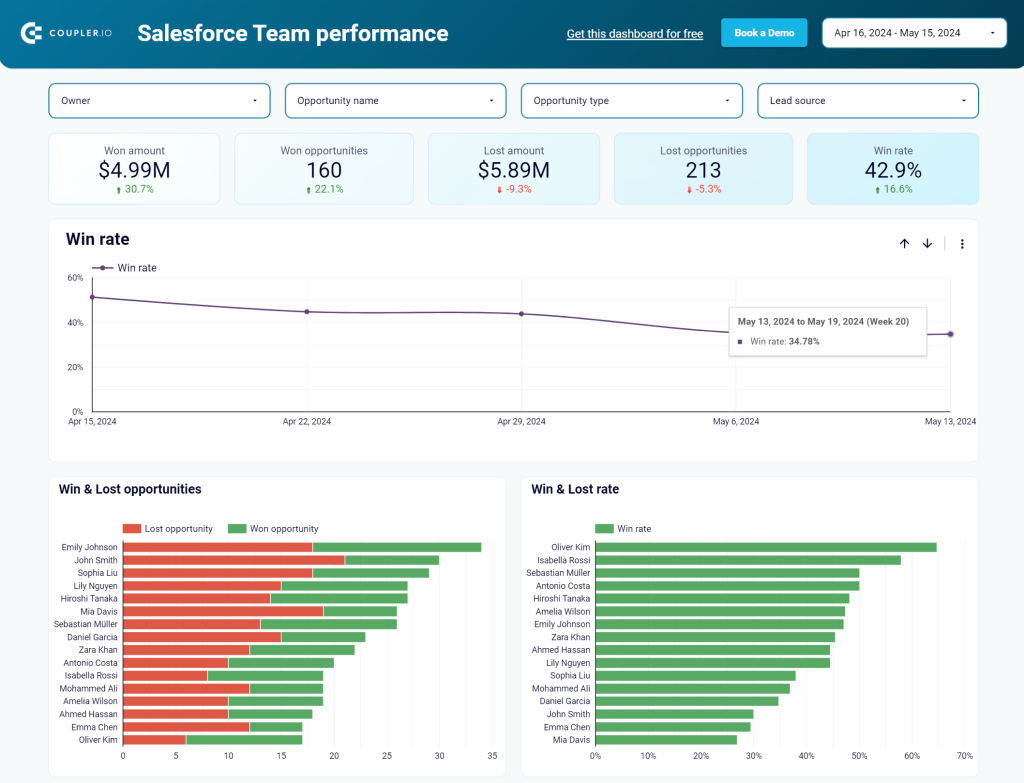
The dashboard is available as a template in Looker Studio and equipped with a no-code Salesforce connector by Coupler.io. So, you only need to connect your Salesforce account to populate the dashboard with your data. In a few minutes, you can track and analyze your employee performance. Try it yourself right away for free.
Time-tracking dashboards
Before time-tracking tools, manual timesheets were the primary method for recording employees’ hours. Despite having the data, analyzing it was challenging due to data inconsistencies. However, time-tracking tools have simplified this process significantly. You can understand different time tracking metrics like hours breakdown, billable amount breakdown, hours by clients, and more from these dashboards.
Time-tracking dashboard for Clockify
Here’s an example of a time-tracking dashboard for Clockify users. Look for data trends to identify high productivity or potential inefficiencies like mismatched billable hours and earnings. Also, you can compare logged hours with active user counts to balance the team workload and prevent burnout.
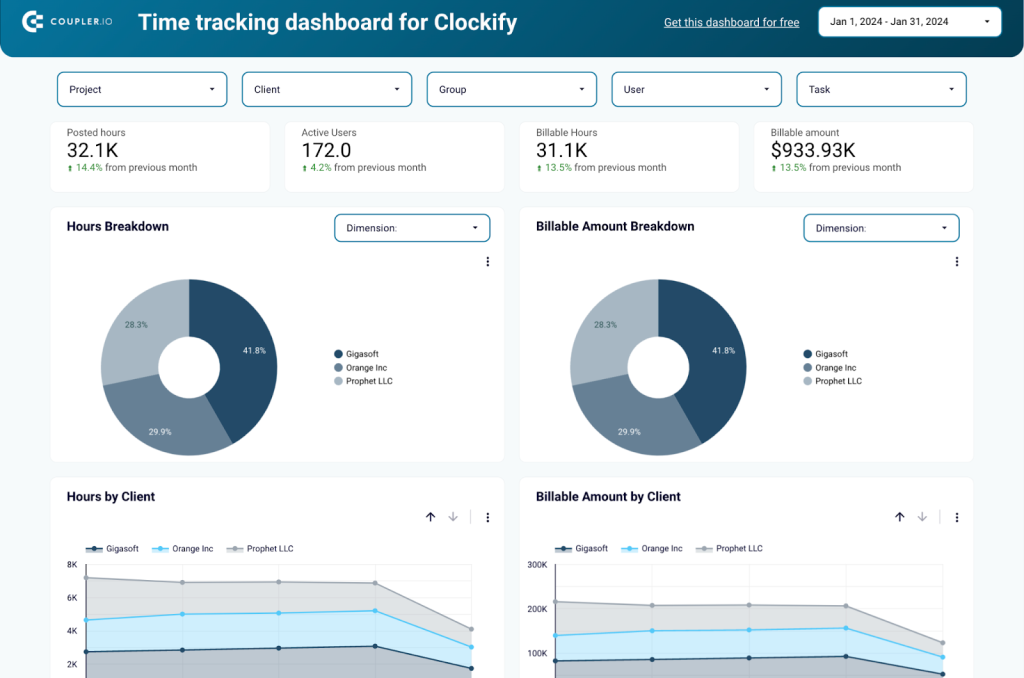
If you use Clockify as your time-tracking tool, then you can use this dashboard template in Looker Studio for your own data. Simply follow the instructions under the Readme tab, and you’ll have your Clockify dashboard set up in just a few minutes.
If you prefer building your reports in spreadsheets, then check out the Clockify time-tracking dashboard in Google Sheets. Basically, this is the same reporting solution introduced above but designed for another destination app. It also has a built-in Coupler.io connector to load data from your Clockify account.
Time-tracking dashboard for Harvest in Looker Studio
Another popular tool for time-tracking is Harvest. It is most commonly used by freelancers and agencies to manage their time and workload across different clients.
This time tracking dashboard for Harvest can give you unique insights like the number of hours spent on each client, users with the most hours, users with the least hours, and more. As an agency, knowing these metrics is crucial to identifying the top-performing employees and profit-generating clients. With such insights, you can optimize your processes, revise your billing, and improve employee productivity.
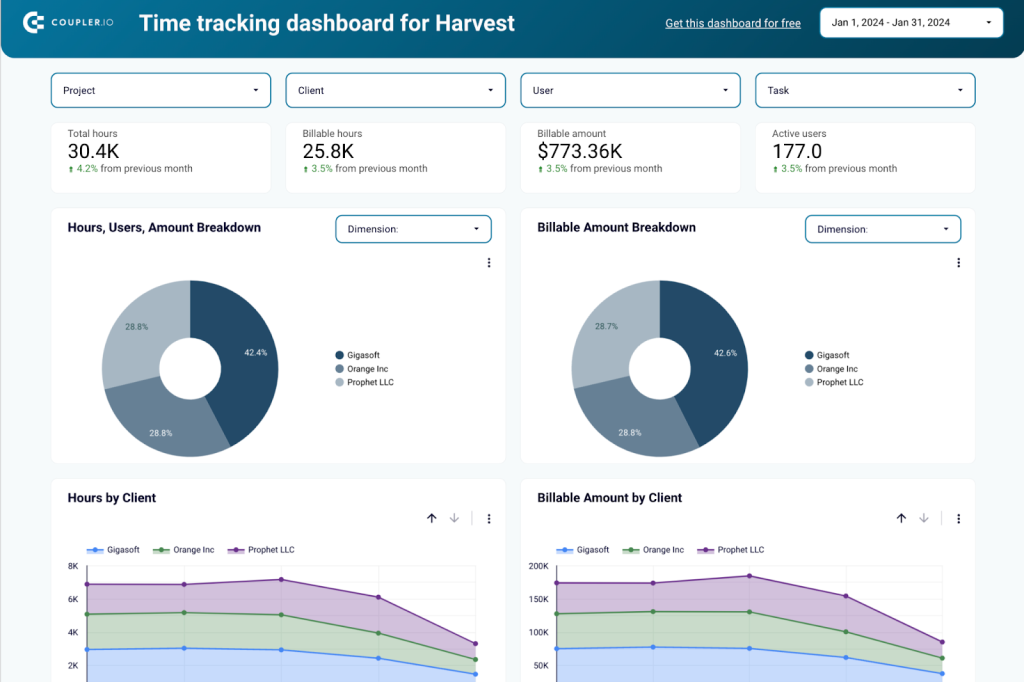
You can also filter the dashboard data by project, client, user, and task to conduct an in-depth analysis.
Google Calendar dashboard
Google Calendar is another tool used in organizations to schedule and conduct meetings. So, it collects different meeting data that can be used in tracking employee performance.
A Google Calendar Dashboard will be useful to know insights like meeting hours, meeting breakdowns, out-of-office hours, and more. Employees in leadership, sales, and customer success tend to spend a lot of time on meetings. Tracking their meeting times and understanding Google Calendar analytics can give better insights into how they use their time.
You can either create a Google Calendar dashboard or export Google Calendar to Google Sheets and BigQuery to store the data.
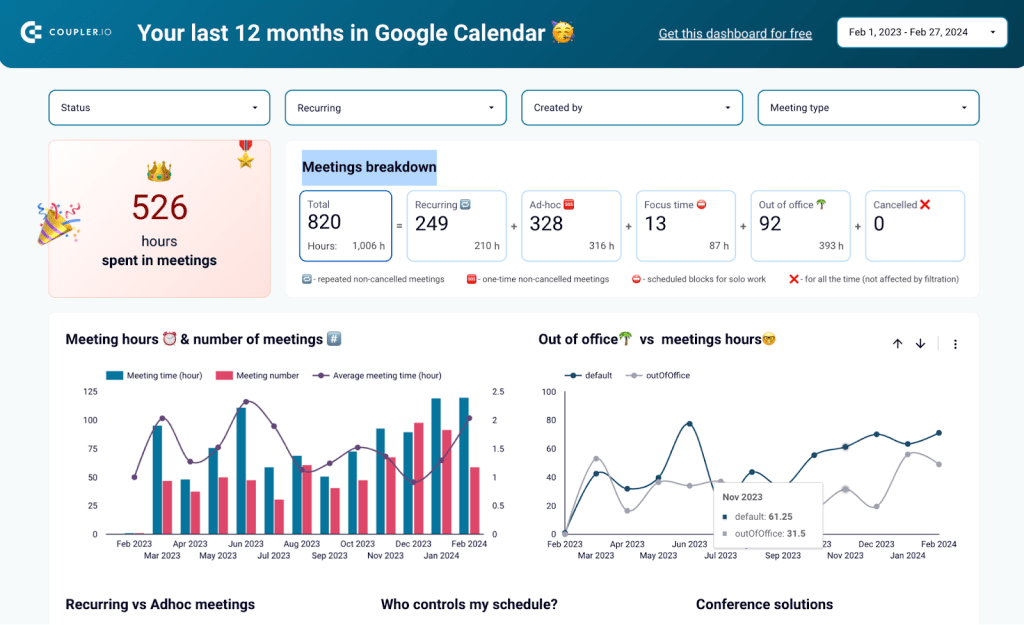
CRM dashboards
A CRM dashboard is primarily used to track the performance of the sales process. But it also has interesting metrics and insights that can help you in tracking employee performance. You can find insights about the sales pipeline by agents, agent comparison, top agents, and worst agents by amount. These metrics can be used to check if the sales agent met their sales goals.
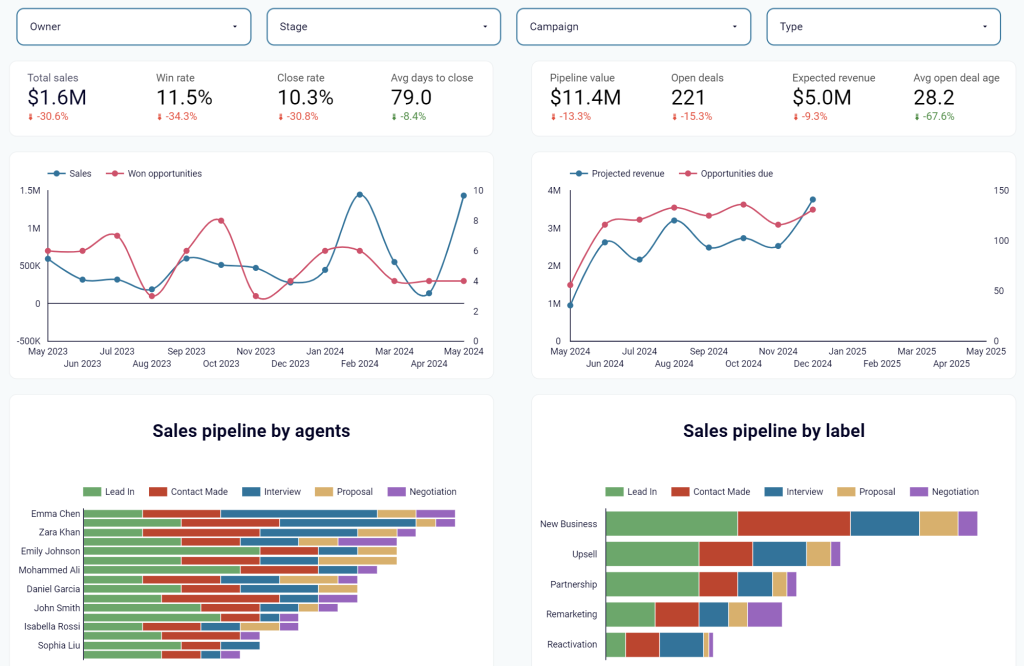
Filter the dashboard data by each sales agent (owner) to get a complete view of the deals closed, the number of deals in progress, the different types of deals they are working on, and the total closed amount. This will help you understand the strengths and weaknesses of each agent and help them to improve accordingly.
Coupler.io provides a CRM dashboard template for different platforms including Salesforce, HubSpot, and Pipedrive. Try the one that meets your analytics requirements.
Employee performance rating dashboard
Employee performance rating dashboards are used during the annual or bi-annual review, where a lot of data is collected from peers, subordinates, managers, and the employee.
The employee performance rating dashboard is a Microsoft Excel template where you can replace the existing scorecard data with your own data to reflect the changes in the dashboard. You can use the same template for collecting data and creating the dashboard.

The first two doughnut charts display the average performance scores and ratings from each supervisor, with the overall average for all employees at the center. You can identify the top employees based on average performance scores and reward them accordingly.
Project management KPI dashboard
If you use project-based evaluations to monitor employee performance, this project management KPI dashboard example will be helpful. You can export data from any project management tool (JIRA, Asana, Trello, etc.) to Excel or Google Sheets and build a similar dashboard.
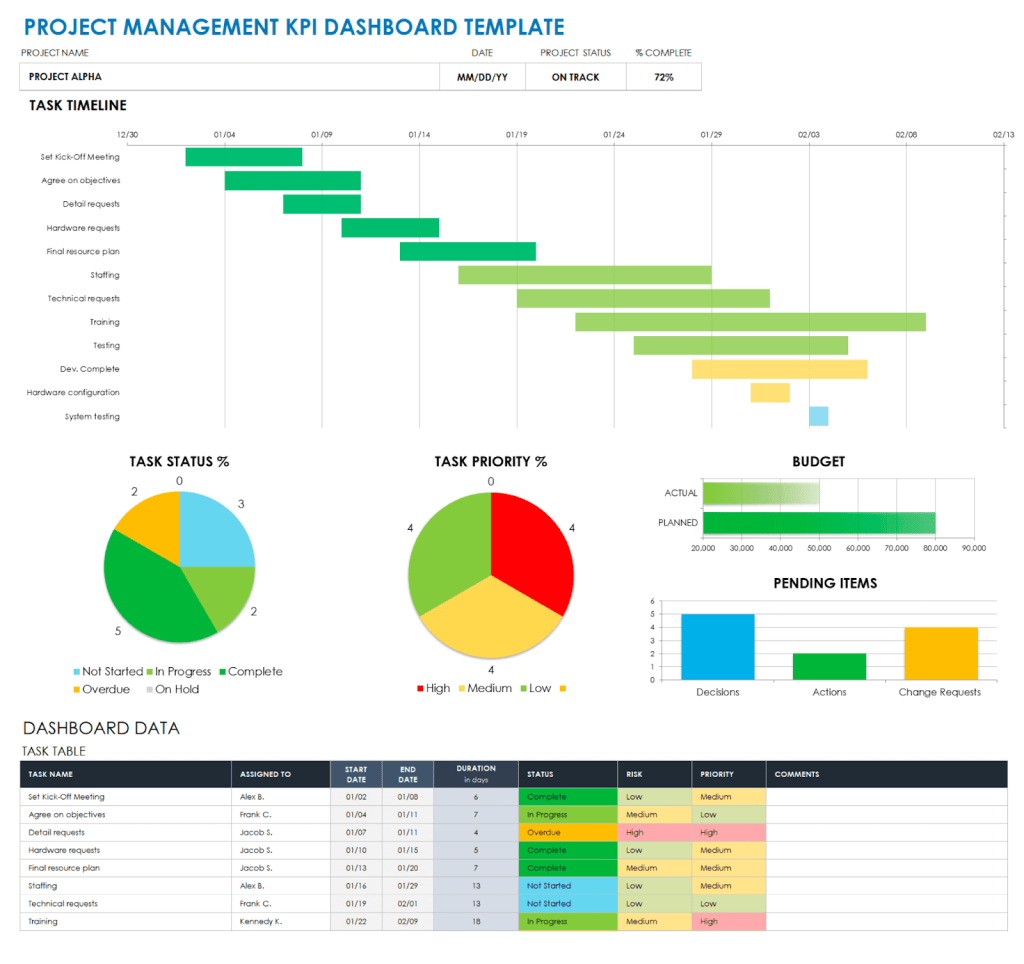
It helps you quickly assess project health and employee performance. You can see who’s on schedule and who’s lagging with the task timeline, and identify bottlenecks using the task status and priority pie charts.
From the task table, you can review workload distribution and manage finances through budget tracking. It’s a tool to manage project efficiency, pinpoint where employees excel, and address areas needing improvement.
Best practices to evaluate employee performance
Nearly every company measures employee performance, but only some manage to do it well and build a skilled team. Along with using different methods, best practices also play a major role in successfully tracking employee performance. By following the best practices discussed below, you do not have to reinvent the wheel and have a smooth journey.
Setup frequent reviews
Employees are 5x more likely to consider feedback as ‘meaningful’ when it’s delivered weekly.
You can start by scheduling weekly 1 to 1 meetings with your team members to talk about challenges, progress, and goals. If weekly feels too often, try bi-weekly reviews. Let the employee speak freely by asking open-ended questions. Then, share your goals for them and make sure they’re comfortable with them.
These meetings are mostly for giving and getting feedback to help both you and your employees grow. Keep notes from each meeting, so you both remember what was discussed. Use these notes for the big yearly review, too, so you don’t forget the small but important stuff they’ve done all year. This makes feedback more useful and helps everyone know what’s expected.
Establish a feedback culture
Use tools like Slack for public thanks and conduct workshops to teach effective feedback methods. Encourage giving feedback every day, create easy-to-use guidelines, and celebrate those who actively engage. Frequent, constructive feedback keeps employees informed about what they’re doing well and where they can improve. A culture that values feedback encourages open communication, promotes professional development, and builds trust within the team.
Give constructive feedback
Constructive feedback is crucial in nurturing employee growth and highlighting specific improvements while giving clear guidance on improving skills or performance. It is in contrast to criticism, which focuses on finding faults without providing an improvement plan.
Constructive feedback is supportive, focusing on how to build on strengths and address weaknesses. For example, rather than saying, “Your presentation was unclear,” you could say, “If you structure your presentation points more sequentially, it will be clearer. Let’s review the slides on organization strategies together.” This method points out areas for improvement and engages in a collaborative effort towards betterment.
Add self-monitoring to your review process
You can incorporate self-monitoring into your review process by having employees assess their own performance on a regular basis. This helps in boosting self-awareness and encourages them to improve actively. Provide tools and clear guidelines for self-assessment, encourage goal setting, and conduct discussion sessions on these self-evaluations.
For example, an employee could keep a weekly log of achievements and challenges, and then use this for monthly progress discussions with their manager. This way, the employee will have clarity about what to talk about in the monthly review meeting.
Do not rely on just time to assess performance
Time tracking alone doesn’t fully measure performance. Combine it with both quantitative metrics, like sales and project completion, and qualitative metrics, like teamwork and leadership, for a full view. Introduce time-tracking tools like Clockify and Harvest to the team, and balance them with other goals and personal growth metrics.
Keep your focus on outcomes, celebrate milestones, and provide regular feedback to ensure time tracking supports your broader performance insights without overwhelming employees.
Provide training on unconscious bias
Training on unconscious bias teaches evaluators to spot and reduce biases like confirmation, gender, and recency bias. By understanding these common prejudices, we can improve performance management’s fairness and effectiveness. Adding practices such as awareness workshops, scenario-based learning, and inclusive evaluation techniques helps minimize bias. You can adapt 360-degree feedback and blind reviews in performance reviews to ensure evaluations are based on merit only.
Benefits of employee performance tracking
Organizations that have highly engaged teams show 21% greater profitability. Tracking your employee performance and helping them grow in their roles with constructive feedback is the first step to building engaged teams.
Along with profitability, below are the benefits of tracking employee performance.
- You can use concrete data to evaluate performance, ensuring fair and unbiased reviews.
- While tracking employee performance, you identify specific skill gaps in certain employees. You can conduct targeted training programs to improve their capabilities.
- Through regular feedback and recognition, employees show increased motivation and job satisfaction.
- It highlights top performers and rewards them accordingly to boost employee engagement.
- By pinpointing areas for improvement, it leads to strategies that boost individual and team productivity.
- It aligns individual performance with organizational goals, making sure everyone is working towards the same objectives.
When is the right time to monitor employee performance?
Monitoring employee performance should be a continuous process throughout the year. But doing too much of it can also be overwhelming to the employee. While you can monitor employee performance continuously using different performance tools, you should have feedback discussions in structured intervals. For example,
- Regular check-ins are times to touch base on work challenges, progress, blockers, and new ideas, scheduled weekly or monthly at your convenience.
- After reaching project milestones, set meetings to review what’s been achieved.
- Conduct traditional performance reviews annually or bi-annually during formal review periods.
- Following training programs, evaluate their effectiveness and how they enhance skills.
- During role transitions, discuss new responsibilities and expectations.
- Lastly, when organizational goals shift, reassess and realign employee objectives to match the new direction.
What is the best way to measure employee performance?
To measure employee performance effectively, start by establishing relevant KPIs and setting OKRs tailored to each individual. Collect quantitative data such as time tracked, project progress, and tasks completed, alongside qualitative aspects like work quality and teamwork.
You can then analyze this data and use dashboards to get a clear visual representation of the performance data. The employee performance dashboards also help in getting quick and actionable insights like productivity patterns, quality benchmarks, and collaboration indicators. It also gives you a complete view of each employee’s contributions.

